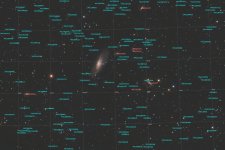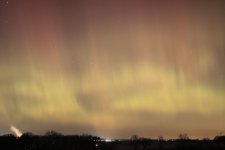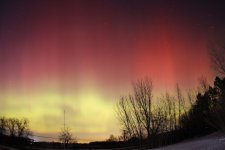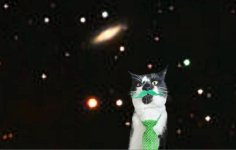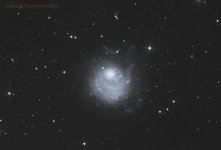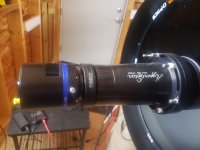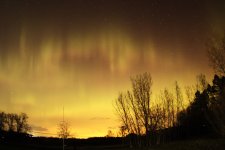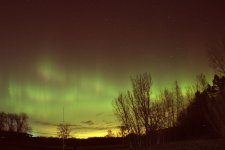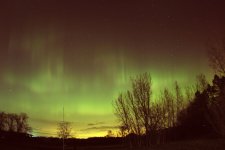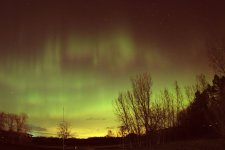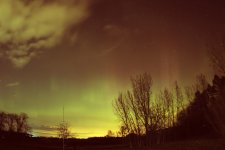You are using an out of date browser. It may not display this or other websites correctly.
You should upgrade or use an alternative browser.
You should upgrade or use an alternative browser.
Astronomy pictures thread
- Thread starter EricTheCat
- Start date
Welcome to the Precious Metals Bug Forums
Welcome to the PMBug forums - a watering hole for folks interested in gold, silver, precious metals, sound money, investing, market and economic news, central bank monetary policies, politics and more.
Why not register an account and join the discussions? When you register an account and log in, you may enjoy additional benefits including no Google ads, market data/charts, access to trade/barter with the community and much more. Registering an account is free - you have nothing to lose!
Tiangong (the Chinese space station) trail with Orion last night
View attachment 7356
Date: 3/14/2023
Camera: Canon Rebel T8i
Lens: 28mm f/1.4 Sigma
Exposure: 5sec at ISO 800 and f/1.4
Processed using PixInsight
PixInsight notes: ABE, Background Neutralization, ColorCalibration, NoiseXterminator, ArcsinhStretch, CurvesTransformation to slightly increase contrast and saturation
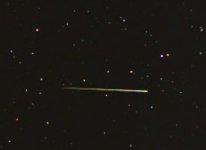
Hurts my head! We are living on a tiny speck of dust.Thanks! Yes here's the annotated version. Love the faint fuzzies. I'm hoping for a chance to go for Markarian's chain next.
View attachment 7489
Like a Chinese space cowboy...
If every galaxy has just one planet with what we consider life then the possibilities are mind boggling.Hurts my head! We are living on a tiny speck of dust.
An unfathomable enigma.If every galaxy has just one planet with what we consider life then the possibilities are mind boggling.
CAPTION: Wolf-Rayet stars are known to be efficient dust producers, and the Mid-Infrared Instrument on NASA’s James Webb Space Telescope shows this to great effect. Cooler cosmic dust glows at the longer mid-infrared wavelengths, displaying the structure of WR 124’s nebula. (Credits: NASA, ESA, CSA, STScI, Webb ERO Production Team.)
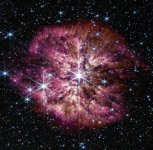

Dang, you pretty far up northThe view from the end of my driveway last night.
View attachment 7658
Markarian's Chain of galaxies (M84, M86, M87, NGC4438, NGC4435, NGC4461, NGC4473, NGC4477 and many others) from last night
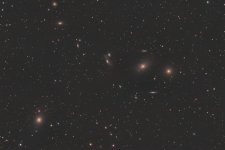
Date: 3/26/2023
Camera: Canon Rebel T8i
Telescope: 92mm f/5.5 triplet (Astrotech AT92) with focal reducer
Exposure: 83x240sec (5hr 32min total) at ISO 400
Annotated image (this one without the PGC catalog which made the image a bit too busy):
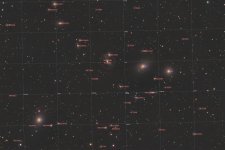

Date: 3/26/2023
Camera: Canon Rebel T8i
Telescope: 92mm f/5.5 triplet (Astrotech AT92) with focal reducer
Exposure: 83x240sec (5hr 32min total) at ISO 400
Annotated image (this one without the PGC catalog which made the image a bit too busy):

Last edited:
Nice pic. I looked it up and saw that it is around 50 million light years away.Markarian's Chain of galaxies
Do you have any idea as to the the distance is between those Galaxies? Like M84 & M86. Any idea how close they are to each other?
My best guess is about 1 arcminute. Probably not the answer you're looking for though.Do you have any idea as to the the distance is between those Galaxies? Like M84 & M86. Any idea how close they are to each other?
I looked it up and saw that it is around 50 million light years away.
Do you have any idea as to the the distance is between those Galaxies? Like M84 & M86. Any idea how close they are to each other?
Based on 50 million light years away, according to this angular size calculator https://www.1728.org/angsize.htm.My best guess is about 1 arcminute. Probably not the answer you're looking for though.
About 14544 light years away from each other.
You would be correct in that assessment. LolMy best guess is about 1 arcminute. Probably not the answer you're looking for though.
That's the kind of answer I was looking for.About 14544 light years away from each other.
The reason I asked is because when looking at your pic, I wondered that if there was someone there looking back our way, would they see our Milky Way and Andromeda as close to each other as we see them.
....but apparently our Milky Way and Andromeda would appear to be much further apart than that.
How well would we be able to see Andromeda if it were only 14544 light years away from us? Seems like it would be very prominent in the sky.
Using same calculator and a few calculations, very roughly Andromeda galaxy would take up about 41 degrees of our sky at 14544 light years.You would be correct in that assessment. Lol
That's the kind of answer I was looking for.
The reason I asked is because when looking at your pic, I wondered that if there was someone there looking back our way, would they see our Milky Way and Andromeda as close to each other as we see them.
....but apparently our Milky Way and Andromeda would appear to be much further apart than that.
How well would we be able to see Andromeda if it were only 14544 light years away from us? Seems like it would be very prominent in the sky.
One way to visualize, if you assume M84 and M86 are roughly the same distance from us, imagine what angle from one of them you would have to make to span the diameter of one of the galaxies with the vertex on the other galaxy. That angle would be roughly the same angle as the angular diameter of the galaxy as seen in their sky.
These are fun things to think about. Thanks for the questions.
No, thank you!These are fun things to think about. Thanks for the questions.
For both the excellent pics, as well as the knowledge of our Universe that you share with us.
....and I think I speak for everyone here when saying that.
Same goes to you too, @foolsgold . The pics and knowledge you share with us is top notch too. Both of you and your work, is much appreciated.
Both of you, please keep it up!
ISS solar transit this morning (one year to the day before the total solar eclipse of 2024!).
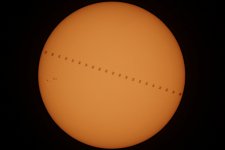
Animated GIF
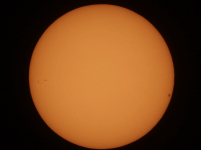
Telescope: 110mm f/7 ED refractor (Orion) with mylar white light solar filter
Camera: Canon Rebel T8i
Exposure: 1/2000 sec at ISO 200
Video mode: 1920x1080 59.94 FPS
Pass details:
Saturday 2023-04-08, 11:45:21.04
ISS angular size: 49.96″
Az.: 145.8°; Alt.: 48.3°
Transit duration: 0.70 s
Angular separation: 0.63′

Animated GIF

Telescope: 110mm f/7 ED refractor (Orion) with mylar white light solar filter
Camera: Canon Rebel T8i
Exposure: 1/2000 sec at ISO 200
Video mode: 1920x1080 59.94 FPS
Pass details:
Saturday 2023-04-08, 11:45:21.04
ISS angular size: 49.96″
Az.: 145.8°; Alt.: 48.3°
Transit duration: 0.70 s
Angular separation: 0.63′
That's amazing. I recognized that galaxy as that really small weird looking one I see off to the side any time I image m101 with my little rigs.
- Messages
- 505
- Reaction score
- 743
- Points
- 268
Yes that's the one. I took this over the course of two nights with Johnson-Cousins R-V-B filters when the skies were good. I am just finishing up a 6 week course on CCD Photometry given by the AAVSO. And a scientific camera arrived today that will be used to take images for IOTA - https://occultations.org/That's amazing. I recognized that galaxy as that really small weird looking one I see off to the side any time I image m101 with my little rigs.
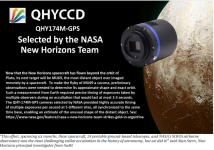
That's awesome. Doing some real science!Yes that's the one. I took this over the course of two nights with Johnson-Cousins R-V-B filters when the skies were good. I am just finishing up a 6 week course on CCD Photometry given by the AAVSO. And a scientific camera arrived today that will be used to take images for IOTA - https://occultations.org/
View attachment 8219
Wait, you had 2 CLEAR NIGHTS!?? I thought this was 2023.
- Messages
- 505
- Reaction score
- 743
- Points
- 268
Eric how naked eye visible were the Aurora? I never see them where I live.Aurora last night. Luckily the sky cleared for a little while. It was a pretty good show.
View attachment 8262
Camera: Canon Rebel T8i (modified)
Lens: 15mm f/2.8 sigma
Exposure: 6sec at ISO 1600 and f/2.8
They were very noticeable. Not quite as bright as the previous display a month ago. The display a month ago I could see them through my kitchen window with my sunglasses on. My skies are close to bortle 5-6 (estimated). I have a very clear view to the North but quite light polluted.Eric how naked eye visible were the Aurora? I never see them where I live.
- Messages
- 505
- Reaction score
- 743
- Points
- 268
What is your Latitude? Mine is 41 degrees.They were very noticeable. Not quite as bright as the previous display a month ago. The display a month ago I could see them through my kitchen window with my sunglasses on. My skies are close to bortle 5-6 (estimated). I have a very clear view to the North but quite light polluted.
44 degrees.What is your Latitude? Mine is 41 degrees.
A couple things I look for when looking for aurora. When it is not obvious I look for vertical features facing North. When they aren't bright enough I don't see color but noticing vertical features helps distinguish aurora from clouds.
Last night it was pretty obvious. Bright green color and a lot of motion including flashing and curtains appearing and disappearing very quickly.
- Messages
- 18,273
- Reaction score
- 11,004
- Points
- 288
Has to be a male nebula.... no female would put up with all that dust....CAPTION: Wolf-Rayet stars are known to be efficient dust producers, and the Mid-Infrared Instrument on NASA’s James Webb Space Telescope shows this to great effect. Cooler cosmic dust glows at the longer mid-infrared wavelengths, displaying the structure of WR 124’s nebula. (Credits: NASA, ESA, CSA, STScI, Webb ERO Production Team.)
View attachment 7552
Aurora time-lapse 4/23/2023
I heard that they were visible in central PA recently, and that is 41.3 degrees North. Pretty close to your 41.Eric how naked eye visible were the Aurora? I never see them where I live.
So there may be hope for you yet.
I'll try to find the vid I saw that mentioned it.
If there's a good reason to miss them that's probably it. I am at my telescope image capture desk right now. I didn't realize it was going to be a good clear night until about the time I was getting dinner ready.




